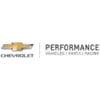Chevrolet Performance LS3 6.2L 376ci Engine w/ Aluminum Heads 430 HP @ 5,900 RPM
809-19432414

| Ratings |
|---|
| Price |
| Brand |
Dress Crate Engine
LS3 6.2L Performance Crate Engine
GM 6.2L LS3 engine features a durable aluminum cylinder block that houses a cast steel crankshaft and durable reciprocating parts. High-flow rectangle port cylinder heads feature a high flowing design for outstanding performance.
LS3 6.2L Engine Specs:
- Engine Type: LS-Series Gen IV Small-Block V-8
- Displacement: 376 ci (6.2L)
- Bore x Stroke: 4.065 x 3.622 in. (103.250 x 92 mm)
- Block: Cast aluminum with six-bolt, cross-bolted main caps
- Crankshaft: Nodular iron
- Connecting Rods: Powdered metal
- Pistons: Hypereutectic aluminum
- Camshaft Type: Hydraulic roller
- Valve Lift: .551 in. intake / .522 in. exhaust
- Camshaft Duration (@.050 in.): 204-degree intake / 211-degree exhaust
- Cylinder Heads: L92 style port; ''as cast'' with 68-cc chambers
- Valve Size: 2.165 in. intake / 1.590 in. exhaust
- Compression Ratio: 10.71
- Rocker Arms: Investment-cast, roller trunnion
- Rocker Arm Ratio: 1.7:1
- Recommended Fuel: 92 octane
- Maximum Recommended rpm: 6600
- Reluctor Wheel: 58X
- Balanced: Internal
Installation Notes:
- Assembly does NOT include any electronics, flexplate, or exhaust manifolds
- Non-Corvette applications require flexplate - - 809-12602448 or 555-601060
- LS3 Controller Kit - 809-19354328, available for non-Corvette/Camaro SS applications - Kit includes an electronic throttle pedal, which is required for throttle input to the ECU.
- Includes Chevy SS mid-wet sump oil pan installed. This oil pan will ONLY fit 2010-15 Camaro SS/ZL1, 2012-15 Caprice PPV, 2014-15 Chevy SS, 2008-09 Pontiac G8 chassis. THIS INSTALLED OIL PAN WILL NOT WORK WITH MUSCLE CAR LS ENGINE SWAPS. OIL PAN CHANGE IS REQUIRED FOR MUSCLE CAR LS ENGINE SWAPS. (Click here to see oil pan dimensions)
- Not intended for marine applications
Engine Break-In Procedure
Use only engine oil that meets dexos1 specifications. For track events or competitive driving, use Mobil 1 15W-50 engine oil. Fill the engine with oil and follow the proper engine priming procedure. Also check and fill as required any other necessary fluids such as coolant, power steering fluid, etc.
Start the engine and listen for any unusual noises. If no unusual noises are noted, run the engine at approximately 1000 RPM until normal operating temperature is reached. The engine should be driven at varying loads and conditions for the first 30 miles or one hour without wide open throttle (WOT) or sustained high RPM accelerations. Run five or six medium throttle (50%) accelerations to about 4000 RPM and back to idle (0% throttle) in gear. Run two or three hard throttle (WOT 100%) accelerations to about 4000 RPM and back to idle (0% throttle) in gear.
Change the engine oil and filter. Inspect the oil and the oil filter for any foreign particles to ensure that the engine is functioning properly. Drive the next 500 miles (12 to 15 engine hours) under normal conditions. Do not run the engine at its maximum rated engine speed. Also, do not expose the engine to extended periods of high load. Change the oil and filter again, inspect the oil and oil filter for any foreign particles to ensure that the engine is functioning properly.
19432414 supersedes 19419862, 19370416
Motor Vehicles
WARNING: Motor vehicles contain fuel, oils and fluids, battery posts, terminals and related accessories which contain lead and lead compounds and other chemicals known to the State of California to cause cancer, birth defects and other reproductive harm. These chemicals are found in vehicles, vehicle parts and accessories, both new and as replacements. When being serviced, these vehicles generate used oil, waste fluids, grease, fumes and particulates, all known to the State of California to cause cancer, birth defects, and reproductive harm.
Tools:
WARNING: Some dust created by power sanding, sawing, grinding, drilling, and other construction activities contains chemicals known to the State of California to cause cancer and birth defects or other reproductive harm. Some examples of these chemicals are: lead from lead-based paints, crystalline silica from bricks and cement and other masonry products, and arsenic and chromium from chemically treated lumber. Your risk from exposure to these chemicals varies, depending on how often you do this type of work. To reduce your exposure, work in a well-ventilated area and with approved safety equipment, such as dust masks that are specially designed to filter out microscopic particles.
Electrical Cords
WARNING: The wires of these products contain chemicals known to the State of California to cause cancer and birth defects or other reproductive harm. Wash hands after handling.
